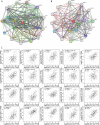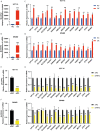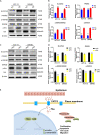SLC27A2 mediates FAO in colorectal cancer through nongenic crosstalk regulation of the PPARs pathway
- PMID: 37041476
- PMCID: PMC10091540
- DOI: 10.1186/s12885-023-10816-3
SLC27A2 mediates FAO in colorectal cancer through nongenic crosstalk regulation of the PPARs pathway
Abstract
Background: Peroxisome proliferator activated receptors (PPARs) are a nuclear hormone receptors superfamily that is closely related to fatty acid (FA) metabolism and tumor progression. Solute carrier family 27 member 2 (SLC27A2) is important for FA transportation and metabolism and is related to cancer progression. This study aims to explore the mechanisms of how PPARs and SLC27A2 regulate FA metabolism in colorectal cancer (CRC) and find new strategies for CRC treatment.
Methods: Biological information analysis was applied to detect the expression and the correlation of PPARs and SLC27A2 in CRC. The protein-protein interaction (PPI) interaction networks were explored by using the STRING database. Uptake experiments and immunofluorescence staining were used to analyse the function and number of peroxisomes and colocalization of FA with peroxisomes, respectively. Western blotting and qRT‒PCR were performed to explore the mechanisms.
Results: SLC27A2 was overexpressed in CRC. PPARs had different expression levels, and PPARG was significantly highly expressed in CRC. SLC27A2 was correlated with PPARs in CRC. Both SLC27A2 and PPARs were closely related to fatty acid oxidation (FAO)‒related genes. SLC27A2 affected the activity of ATP Binding Cassette Subfamily D Member 3 (ABCD3), also named PMP70, the most abundant peroxisomal membrane protein. We found that the ratios of p-Erk/Erk and p-GSK3β/GSK3β were elevated through nongenic crosstalk regulation of the PPARs pathway.
Conclusions: SLC27A2 mediates FA uptake and beta-oxidation through nongenic crosstalk regulation of the PPARs pathway in CRC. Targeting SLC27A2/FATP2 or PPARs may provide new insights for antitumour strategies.
Keywords: Colorectal cancer; FAO; PPARs; SLC27A2.
© 2023. The Author(s).
Conflict of interest statement
The authors declare no competing interests.
Figures





Similar articles
-
Overexpression of PGC-1α increases peroxisomal activity and mitochondrial fatty acid oxidation in human primary myotubes.Am J Physiol Endocrinol Metab. 2017 Apr 1;312(4):E253-E263. doi: 10.1152/ajpendo.00331.2016. Epub 2017 Jan 10. Am J Physiol Endocrinol Metab. 2017. PMID: 28073778 Free PMC article.
-
Upregulated SLC27A2/FATP2 in differentiated thyroid carcinoma promotes tumor proliferation and migration.J Clin Lab Anal. 2022 Jan;36(1):e24148. doi: 10.1002/jcla.24148. Epub 2021 Dec 2. J Clin Lab Anal. 2022. PMID: 34854499 Free PMC article.
-
Peroxisome proliferators and peroxisome proliferator activated receptors (PPARs) as regulators of lipid metabolism.Biochimie. 1997 Feb-Mar;79(2-3):81-94. doi: 10.1016/s0300-9084(97)81496-4. Biochimie. 1997. PMID: 9209701 Review.
-
Yarrowia lipolytica AAL genes are involved in peroxisomal fatty acid activation.Biochim Biophys Acta. 2016 Jul;1861(7):555-65. doi: 10.1016/j.bbalip.2016.04.002. Epub 2016 Apr 9. Biochim Biophys Acta. 2016. PMID: 27067366
-
Positive regulation of the peroxisomal beta-oxidation pathway by fatty acids through activation of peroxisome proliferator-activated receptors (PPAR).Biol Cell. 1993;77(1):67-76. doi: 10.1016/s0248-4900(05)80176-5. Biol Cell. 1993. PMID: 8390886 Review.
Cited by
-
The Role of Adipocytes Recruited as Part of Tumor Microenvironment in Promoting Colorectal Cancer Metastases.Int J Mol Sci. 2024 Jul 30;25(15):8352. doi: 10.3390/ijms25158352. Int J Mol Sci. 2024. PMID: 39125923 Free PMC article. Review.
-
Integrative Meta-Analysis: Unveiling Genetic Factors in Meat Sheep Growth and Muscular Development through QTL and Transcriptome Studies.Animals (Basel). 2024 Jun 4;14(11):1679. doi: 10.3390/ani14111679. Animals (Basel). 2024. PMID: 38891726 Free PMC article.
References
MeSH terms
Substances
Grants and funding
LinkOut - more resources
Full Text Sources
Medical
Miscellaneous

